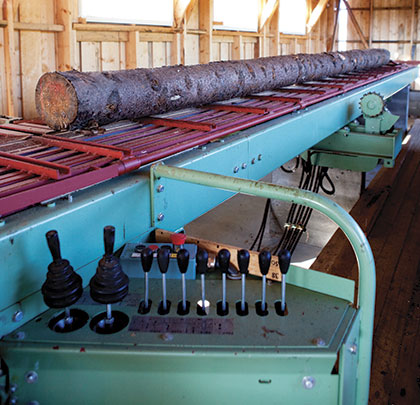Humans have been using wood to construct shelters and other buildings for thousands of years. With the advent of metal tools wood could be cut and shaped making it more useful in serving our needs. The ability to transform wood into useful shapes was further enhanced with the invention of the first sawmill in the third century A.D. It was built in what is now Turkey and was powered by water to cut stone. Water was still being used for power when the first sawmills were built in the colonies of the new world, the first of which was established on the bank of the Piscataqua River near what is now York, Maine.
The ability to process trees into boards and planks largely directed the settlement of North America. Where there was flowing water there was power for a sawmill and the ability to more efficiently build homes and businesses. Rivers were also used to transport the felled trees to the mill and the finished lumber to the end users.
THE GROWING DEMAND FOR LUMBER
In 1955 three brothers took a gamble that they could successfully capitalize on the growing demand for lumber and bought their first sawmill in Quesnel, British Columbia. Two years later the Ketcham brothers were approached to participate in a near bankrupt sawmill in the Chilcotin region west of Williams Lake and the Fraser River, giving rise to the name West Fraser.
After sixty years, West Fraser has grown to the largest lumber producer in North America. With forty facilities in Canada and the United States, West Fraser produces not only lumber, but also fiberboard, plywood, laminated veneer, wood pulp, and paper.
West Fraser is also using and actively developing new technologies that create energy efficiency and generate power from waste products in its plants. In 2012 West Fraser installed a 27 megawatt condensing steam co-generation turbo generator that uses wood waste to generate power and steam for the Cariboo Pulp & Paper mill’s operation in Quesnel. Fed by biomass from local operations, the generator produces power for the site, and provides enough additional power to B.C.’s provincial grid to supply more than 14,500 homes annually.
A PHILOSOPHY OF SUSTAINABILITY
It’s not surprising that this forward-thinking company is interested in sustainability. In 1954 the Ketchums signed their first Forest Management Agreement (FMA) with the government of Alberta. Forestlands in Canada are publicly owned and tightly regulated. Today, West Fraser operates under some of the toughest environmental regulations in the world, which require it to sustainably manage the forestlands as well as the watershed, environment, and habitat. By 2011, West Fraser had planted more than 1.2 billion trees since the company was founded to replace those it had harvested.
This culture of sustainability has become an integral part of the West Fraser corporate philosophy. In 1994 the company voluntarily relinquished harvesting rights to the largest intact coastal temperate rainforest on earth: the Kitlope. At 1,225 square miles, the area is equivalent to the entire forested area of the Netherlands. Now called the Kitlope Heritage Conservancy, the decision to protect the area is an example of West Fraser’s commitment to environmental stewardship. Another example was seen in 2007, when the company deferred harvesting 370,000 acres in Alberta and British Columbia in order to safeguard caribou habitat.
In 2000 the company made its first foray into the United States and West Fraser South was born. Two sawmills were acquired from Plum Creek Timber Co., one in Huttig, Arkansas, and the other in Joyce, Louisiana.
A LOOK AHEAD
On March 31, 2007, West Fraser completed the acquisition of thirteen sawmills in the southern United States from the International Paper Company. Upon completion of the transaction, West Fraser became one of the largest lumber producers in North America with a combined Canadian and U.S. capacity of approximately 6.2 billion board feet.
One of these newly acquired sawmills is in the small town of Leola, Arkansas, population 501. The sawmill produces lumber from southern yellow pine. West Fraser does not own or manage any forestland in the United States, instead, the logs are secured from third party sources. ◆
For More Information:
Mike Bjorkman is vice president of BJM Corp. and has more than thirty years of experience in the pump industry. He serves as director of marketing and IT for BJM Pumps, LLC and All Test Pro, LLC. Both companies are subsidiaries of BJM Corp. Mike can be reached at 860.399.5937. BJM Pumps, established in 1983, supplies electrical submersible pumps to industrial and municipal markets throughout the United States, Canada, and South America. For more information, visit www.bjmpumps.com.
____________________________________________
MODERN PUMPING TODAY, March 2016
Did you enjoy this article?
Subscribe to the FREE Digital Edition of Modern Pumping Today Magazine!
![]()


